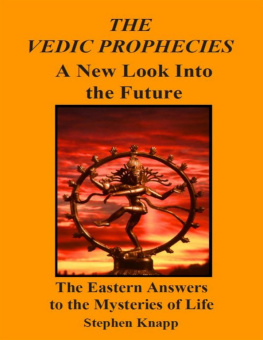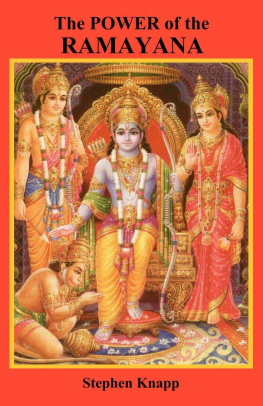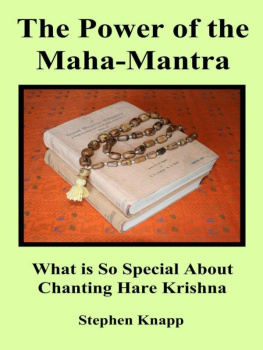Stephen Knapp - Spiritual India Handbook
Here you can read online Stephen Knapp - Spiritual India Handbook full text of the book (entire story) in english for free. Download pdf and epub, get meaning, cover and reviews about this ebook. year: 2020, genre: Religion. Description of the work, (preface) as well as reviews are available. Best literature library LitArk.com created for fans of good reading and offers a wide selection of genres:
Romance novel
Science fiction
Adventure
Detective
Science
History
Home and family
Prose
Art
Politics
Computer
Non-fiction
Religion
Business
Children
Humor
Choose a favorite category and find really read worthwhile books. Enjoy immersion in the world of imagination, feel the emotions of the characters or learn something new for yourself, make an fascinating discovery.
- Book:Spiritual India Handbook
- Author:
- Genre:
- Year:2020
- Rating:5 / 5
- Favourites:Add to favourites
- Your mark:
- 100
- 1
- 2
- 3
- 4
- 5
Spiritual India Handbook: summary, description and annotation
We offer to read an annotation, description, summary or preface (depends on what the author of the book "Spiritual India Handbook" wrote himself). If you haven't found the necessary information about the book — write in the comments, we will try to find it.
Spiritual India Handbook — read online for free the complete book (whole text) full work
Below is the text of the book, divided by pages. System saving the place of the last page read, allows you to conveniently read the book "Spiritual India Handbook" online for free, without having to search again every time where you left off. Put a bookmark, and you can go to the page where you finished reading at any time.
Font size:
Interval:
Bookmark:


Published by Jaico Publishing House A-2 Jash Chambers, 7-A Sir Phirozshah Mehta Road
Fort, Mumbai - 400 001
www.jaicobooks.com
Stephen Knapp
Published in arrangement with
Stephen Knapp
180 Lenox Street
Detroit, Michigan
48215, USA
SPIRITUAL INDIA HANDBOOK
ISBN 978-81-8495-024-3
First Jaico Impression: 2009
Fourth Jaico Impression: 2011
No part of this book may be reproduced or utilized in any form or by any means, electronic or
mechanical including photocopying, recording or by any information storage and retrieval system,
without permission in writing from the publishers.
Printed by
Dedicated to all Pilgrims
Who carry with them
e hope and intention of
Reaching a higher perception of
Who they really are
Introduction
Reading about Eastern philosophy is one thing, but going to Eastern lands and actual y experiencing it is quite another. Seeing the local people who understand and practice this knowledge in their customary surroundings can be quite enlightening, but it can also be perplexing if you do not know what is happening or the reasons behind what people do.
India, like other places in the world that have unusual mystical traditions, is a land that can be both physical y and mental y demanding.
India is an exotic, beautiful, and wondrous country, depending on what aspects of it you see. Living and traveling there can be pleasant and exciting, but it is also likely to provide you with many trying situations. It can be terribly hot, dry, and dusty. Good food and water may not always be readily available. And living conditions and transportation can oen leave much to be desired. But it is a total experience on every level: a testing ground that is not for everyone. It can separate the serious from the frivolous; the real truth-seekers from the superficial and worldly sightseeing tourists. But if you want the real treasure of India, the spiritual heritage of the East, it can be found if you are determined. But you have to know where to look and how to find it.
When entering India, you wil most likely go through one of three places: Kolkata, Mumbai, or New Delhi. Like any big city, they can be somewhat overwhelming if you do not know where to go or how to handle the various situations that one is likely to encounter, especial y in such a different culture. Some people may handle it quite easily, while others wil find that the difference in lifestyle wil make them ask, Why did I ever think I wanted to come to this place? For those, India may be a country where they stop long enough merely to see the Taj Mahal, the Jaipur Palace, and a few other places before going on to some other part of the world. en they can say that they have been to India. But whether they actual y see the real life of the people is another thing.
When visiting India, you have to be wil ing to readjust the way you see the world. It is a country that moves slowly. For example, trains and buses are oen late. So you must have patience and plenty of tolerance, otherwise you may experience much to complain about and little of the beauty and wonder that exists there. You have to look beyond the poverty, the dirt, dust, smel s, and overcrowded living conditions in the cities if you expect to enter into the mysteries of Indias spiritual culture.
If you are attached to your Western ways or particular standards of comfort and are not wil ing to adjust, then, quite honestly, you have no business going to India, not at least if you are looking for its spiritual aspects. To do that requires you to drop your guard and your pretenses, and get out amongst the people, especial y the sadhus or holy men, and see them as they are, doing their regular business, visiting their temples and attending their religious festivals. Whether you understand it al or not, it is bound to awaken a part of you that you never knew existed or have rarely experienced. You may either be confused by it, or you may find that you
are quite at home with it, feeling a spiritual tranquility, the likes of which you have hardly realized before.
Attaining this spiritual serenity is a matter of evolving your consciousness. And how can your consciousness evolve if you do not decondition yourself from the habitual materialistic thought patterns in which you have grown accustomed? You must set aside your normal (or is it unnormal?) everyday ways of thinking in order to look at things from an entirely new perspective, a different state of mind. is is what expanding your consciousness and becoming aware of higher realms of existence is al about. And this is the real spiritual heritage of India. It offers an individualistic process of personal transformation and development for understanding yourself, your position in the universe, and your relationship with the Supreme. However, let us remember that the goal of Eastern philosophy or yoga is not to escape or cut yourself off from the outside world, but it is to BRING IN the awareness of self, the understanding of your real identity. Upon attaining this perception, one is never shaken in any situation. Of course, this does not mean that if you go to India you wil see everyone intensely absorbed in this aspect of life. Like any place else, most people wil simply be engaged in the struggle to survive, work, career, or ways to make money. Nonetheless, the people of India, general y speaking, are the most spiritual y oriented people in the world.
In ones attempt to see the spiritual side of India, it is very important to know where to go and what to see in order to maximize whatever spiritual experiences you are looking for. Natural y, some places have more to offer than others, and certain towns are more sacred to specific religions or spiritual paths.
ere are places in India like Vrindavan, Mathura, Mayapur, Dwarka, Varanasi, Puri, and others, as wel as rivers like the Ganges or Yamuna, which exist and can be experienced in the normal three dimensional way.
But these places are said to also exist in the spiritual realm, the higher dimension. is means that these places are where the material and spiritual energies overlap. Although the spiritual energy may pervade the universe, at such holy places or tirthas the experiences of higher dimensions are easier to attain. is is what gives these places special meaning amongst those who can perceive or know of this multidimensional aspect. is depends, however, on how receptive and elevated the person is in spiritual knowledge and awareness.
For those who are not spiritual y aware, these cities and rivers wil appear as no different from any other. Such people wil say that the Ganges is not a holy river, that the Deities in the temples are merely stone idols, and that the sages are ordinary men. But the Vedic texts say that people with such a vision have a hel ish mentality. ey are forced by their own limitations of consciousness to be aware of nothing more than the most base level of existence and cannot perceive the higher realms of life that are al around us. For them this three dimensional material universe holds more mysteries than they can imagine, what to speak of the spiritual dimension which they cannot see at al .
From the gross sensory perspective, many of the values the people of India have, as wel as activities they perform in the name of spirituality, wil be completely bewildering for an uncultured tourist who lacks the spiritual knowledge that India has to offer. Such people may see a variety of activities, customs, and traditions that people enthusiastical y perform in their abandonment for unity between the soul and God. Yet the average
Next pageFont size:
Interval:
Bookmark:
Similar books «Spiritual India Handbook»
Look at similar books to Spiritual India Handbook. We have selected literature similar in name and meaning in the hope of providing readers with more options to find new, interesting, not yet read works.
Discussion, reviews of the book Spiritual India Handbook and just readers' own opinions. Leave your comments, write what you think about the work, its meaning or the main characters. Specify what exactly you liked and what you didn't like, and why you think so.












